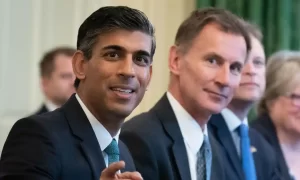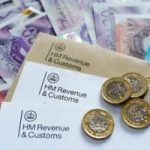
Rishi Sunak is facing mounting Tory unrest as he imposes the biggest tax rise since the 1970s, dragging millions of middle earners into the 40p rate of income tax.
The Institute for Fiscal Studies (IFS) says that many teachers, nurses and electricians are among the one in five taxpayers who will be paying a rate designed for the wealthy because of a six-year freeze on thresholds.
Sunak’s use of fiscal drag to raise revenue should be seen as a “very large tax increase” that is super-charging a “seismic” change to the tax system that piles more of the burden on to those in normal jobs, the think tank says.
Only people earning more than £100,000 would pay the 40p rate if it were restricted to the same proportion of the population who paid it a generation ago. Instead, cliff edges in the tax system will mean the same number of workers pay effective rates of 45p and 60p as paid 40p a generation ago.
The findings have intensified calls from the Conservative right for Sunak to bring forward tax cuts in the wake of the party’s disastrous performance in local elections this month. Cabinet ministers are privately urging the prime minister to move faster.
Simon Clarke, a former housing secretary, said: “This analysis shows the worst is yet to come. We need to cut spending and taxes to ease the pressure on family finances and we need to have a moment of levelling with the public that our current economic trajectory is simply unsustainable.
“That needs to begin before the next election and we need to set out a clear plan to bring income tax rates down and unfreeze the thresholds at which people pay the different rates so as to reflect the stealth effects of inflation.”
Tories on the right of the party are becoming increasingly vocal in the wake of the local elections. On Monday Suella Braverman delivered a wide-ranging speech seen as a pitch for the future leadership.
Income tax thresholds typically have risen in line with inflation, but when chancellor in 2021, Sunak froze the salary at which people start paying income tax at £12,570 and the higher rate at £50,270 — a measure extended until 2028 by Jeremy Hunt, the present chancellor.
The Office for Budget Responsibility has said this will drag 2.1 million people into the higher rate of tax, raising up to £26 billion a year, or the equivalent of 4p on the basic rate.
The IFS calculates that as a percentage of GDP this will be the biggest tax increase since Geoffrey Howe almost doubled VAT to 15 per cent in 1979, which raised £46 billion in 2027 prices. Isaac Delestre, author of its report, said the tax freeze was “significantly bigger” than the hugely controversial rise in corporation tax to 25p last month, raising £18 billion in comparable terms, as well as previous rises, such as the abolition of the 10p tax rate in 2008 or the increase in VAT to 20 per cent in 2011, which raised £21 billion in 2027 prices.
In 1991-92, only 3.5 per cent of adults paid the 40p rate. This will increase to 14 per cent by 2027, or 7.8 million adults. That amounts to 20 per cent of the 38 million adults projected to be paying income tax in 2027. Almost no nurses paid 40p tax in the early 1990s, but by 2027 more than one in eight will do so. The proportion of teachers, machinists and electricians paying the rate will go from one in twenty to one in four.
Half of lawyers and other legal professionals will be paying 40p tax, up from just over a third. Almost half of architects and surveyors will be in the higher rate, up from less than a fifth a generation ago.
Delestre said rising numbers paying 40p tax represented “a fundamental and profound change to the nature and structure of our income tax system”, adding: “The freeze to thresholds is supercharging that process . . . Whether or not the scope of these higher rates should be expanded is a political choice as much as an economic one, but achieving it with a freeze leaves the income tax system hostage to the vagaries of inflation.”
He also criticised the “unwelcome proliferation” in marginal tax rate “spikes”. These include the withdrawal of the personal allowance for people on more than £100,000, which results in an effective 60p rate until the top 45p rate kicks in at £125,140. Withdrawal of child benefit for people earning more than £50,000 creates effective rates of more than 55p, which Delestre said was a disincentive to work more or to find a new job at a time of labour shortages.
One former cabinet minister said: “It is crucial that we go into the next election proving that we have cut taxes for hardworking families, stopping people like middle-ranking policemen, experienced teachers and many junior doctors paying 40 per cent income tax.”
A Treasury spokesman argued that the government had prioritised raising the tax-free personal allowance to benefit low earners, saying: “After borrowing hundreds of billions to support the economy during the pandemic and Putin’s energy shock, we had to take some difficult decisions to repair the public finances and get debt falling.”
Read more:
Millions face income tax rise that will put them in 40p band





